

| Archive Blog Cast Forum RSS Books! Poll Results About Search Fan Art Podcast More Stuff Random |
|
Classic comic reruns every day
|
1 {photo of a road and surrounding countryside after a rainstorm}
1 Caption: After the rain
|
First (1) | Previous (3247) | Next (3249) || Latest Rerun (2891) |
Latest New (5380) First 5 | Previous 5 | Next 5 | Latest 5 Annotations theme: First | Previous | Next | Latest || First 5 | Previous 5 | Next 5 | Latest 5 This strip's permanent URL: http://www.irregularwebcomic.net/3248.html
Annotations off: turn on
Annotations on: turn off
|
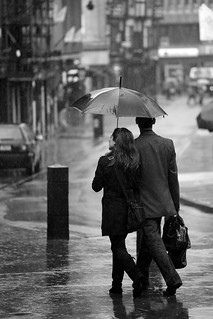 Rain in the city. |
Rain reminds us that however much we impose our collective will on nature, we can't have it all our own way. Storms happen, and we have to weather them. Isaac Asimov wrote in his series of science fiction detective novels that begins with The Caves of Steel about a future in which human civilisation lives in cites under enormous steel domes, never seeing the natural world outside. Forced outdoors by circumstance, the protagonist, Elijah Bailey, is shocked and horrified when water falls on him! Most of us take steps to avoid getting too wet in the rain, but thankfully for us we're usually not physically repulsed by the very idea.
Rain is just one of the forms of water falling from the sky. If the temperature at cloud level is freezing, the water can condense into pellets of ice and fall as hail. If it's cold near ground level, you can get sleet or snow. No matter the form, water falling from the sky is grouped together under the term precipitation.
Precipitation falls in most places on Earth. It falls on the oceans, where it adds to the giant repositories of water already there. It falls on land near the coasts, where many humans live. It falls inland too, over vast plains and high up in mountains. There are some places where precipitation is very scarce - we generally refer to such places as deserts. This includes the traditional hot, sandy deserts that most people think of when they hear the word, as well as colder places like high plateaus and some arctic regions. The weather patterns of the world tend to skip these places when it comes to dishing out the water, either because of the overall patterns of wind around our planet, or the local effect that mountain ranges have on the flow of that wind.
Where rain falls on land, it first gets things wet. The initial drops might soak into the ground, particularly if it's soil, but also into the upper layer of concrete and buildings in our cities. If it continues, however, the ground soon becomes saturated and water starts pooling up on the surface, forming puddles. Puddles are great fun for little kids, but mostly an annoyance for everyone who doesn't want to get their feet wet. Not to mention those puddles that form on the side of the road when the drains are blocked, and that buses will splash up in great waves all over anyone standing nearby (say, waiting for a bus).
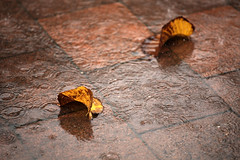 Rain puddle. |
A creek near my home runs down directly into a harbour, where it joins the salty water that washes up and down the mangrove-laden mudflats. Creeks further inland run down into valleys, where they join forces to become rivers. Mountain rivers are rough and tumble affairs, with water cascading down slopes, over rocks and boulders. Sometimes the river drops over a cliff, forming a waterfall. This is where you get rapids, where people emerging from childhood (or in an extended one) enjoy dealing with the white water in kayaks.
As a river heads down out of the mountains and on to nearby plains, it slows down and broadens out. It changes from a swift-running mass of water determined to get as far downhill as quickly as possible, into a lazy wanderer. It may cut canyons through stone over millions of years. It may meander aimlessly across a broad, flat plain, changing direction seemingly on a whim, looping and curling, and sometimes cutting back across itself. The loops in such a river may become separated from the flowing water as the river finds a short cut. Such loops become what are called oxbow lakes, or in Australia the more poetic name of billabongs. These stages of a river support the more laid back pursuits of boating and fishing.
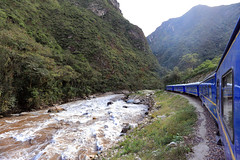 Mountain river. |
Under the ground there is a whole subterranean world of other rivers and lakes that we scarcely think about. Soil is porous, and some types of rock are too. These soils and rocks absorb water, and the water moves slowly downwards through them until eventually it hits a layer of impermeable rock. This layer of rock that the water cannot soak into serves as a sort of underground "surface" on which the water spreads out in a way very similar to how it behaves on the land surface we're familiar with. Where the impermeable layer slopes, the water runs downhill. Where it forms depressions, the underground water pools and forms "lakes", sometimes immense ones. The top surface of this layer of underground water is called the water table.
This underground water can be found and released by drilling wells down as far as the water table and then pumping it to the surface. It can also work its way to the surface naturally, by flowing down the underground hill until it reaches a point where the actual surface of the Earth above has dropped in altitude enough to expose the underground water. This means the Earth's surface intersects the water table. Such places become natural springs, where water bubbles out of the ground to join the system of lakes and rivers we see.
 Mature, winding, lowland river. |
All this is one half of the story. It begins with rain and other forms of precipitation, and ends with the resulting water in the ocean, or in lakes, or underground, or being used by plants and animals. If this was the whole story, the sky would soon run out of rain. The water has to get back up there somehow. Water returns to the sky by the processes of evaporation and transpiration.
Water lying on the surface of the Earth—which includes puddles, streams, rivers, lakes, and oceans—is exposed to the air. The molecules of water are all jiggling around, with a distribution of velocities consistent with the kinetic energy at their current temperature. Some of the molecules at the high end of this velocity distribution have enough speed (or energy) to break free of the attractive forces of the surrounding water molecules, which means they can move up into the air. Once in the air, they can diffuse upwards and further away from the standing water. Some of the water molecules in the air immediately above the water will also happen to be moving downwards and join the mass of water below. If the air is thick with water vapour, these two processes can be in equilibrium, meaning the rate of water molecules leaving the water into the air is the same as the rate of molecules leaving the air into the water. More usually, however, the diffusion of the water molecules into the air, combined with any large scale movements such as breezes and wind, carries the newly risen water molecules away, so that the rate of molecules moving from the water into the air is higher than the return rate. The net result is that water molecules slowly disappear from the standing water, into the air. This is the process of evaporation.
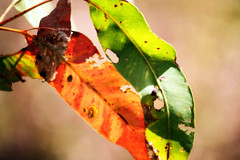 Transpiration occurs in leaves. |
The good thing about the processes of evaporation and transpiration is that they operate on individual water molecules. This means that the water that returns to the atmosphere is essentially pure. Water evaporated off the surface of the ocean contains none of the salts and minerals that make it deadly for most land animals and plants (including us) to drink. It's fresh, clean, pure water.
Once back in the air, water vapour is carried around the globe by winds. Winds are caused by a combination of heating of the Earth's surface by the sun, the forces of Earth's rotation, and the local geography in various places around the world. Most of the evaporation occurs over the ocean, and most of the transpiration over large tropical forests, but winds carry the resulting water-laden air far and wide, over lands that need the water. Not over all the lands that need water, though. The vagaries of the wind, and the blocking effect of mountain ranges, means that some places receive very little rainfall, becoming the deserts mentioned earlier. But elsewhere, the winds bring moisture, and when the local conditions are right it comes tumbling down out of the sky to refresh the land, and us.
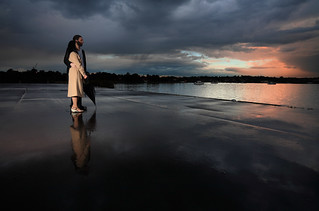 Stop and enjoy the smell of the rain. |
And after a dry spell, when the soil in the ground around you is parched and the plants are getting desperate for water, the rain falling from the sky interacts with chemicals in the soil. Geosmin is an organic compound produced by several common species of bacteria that live in the soil. There are also oils and other compounds released by plants. All these things lie dormant and unheeded in the dry soil. The moisture provided by rain interacts with these compounds, mixing them and allowing them to rise into the air. Our noses are very sensitive to these compounds, and it is this we smell after rain, particularly on a hot day after a dry spell. It is one of the most evocative smells in human experience, and can briefly make you forget everything except the desire to frolic in the rain and experience our intimate connection with the world around us.
That smell has a name: petrichor.
|
LEGO® is a registered trademark of the LEGO Group of companies,
which does not sponsor, authorise, or endorse this site. This material is presented in accordance with the LEGO® Fair Play Guidelines. |